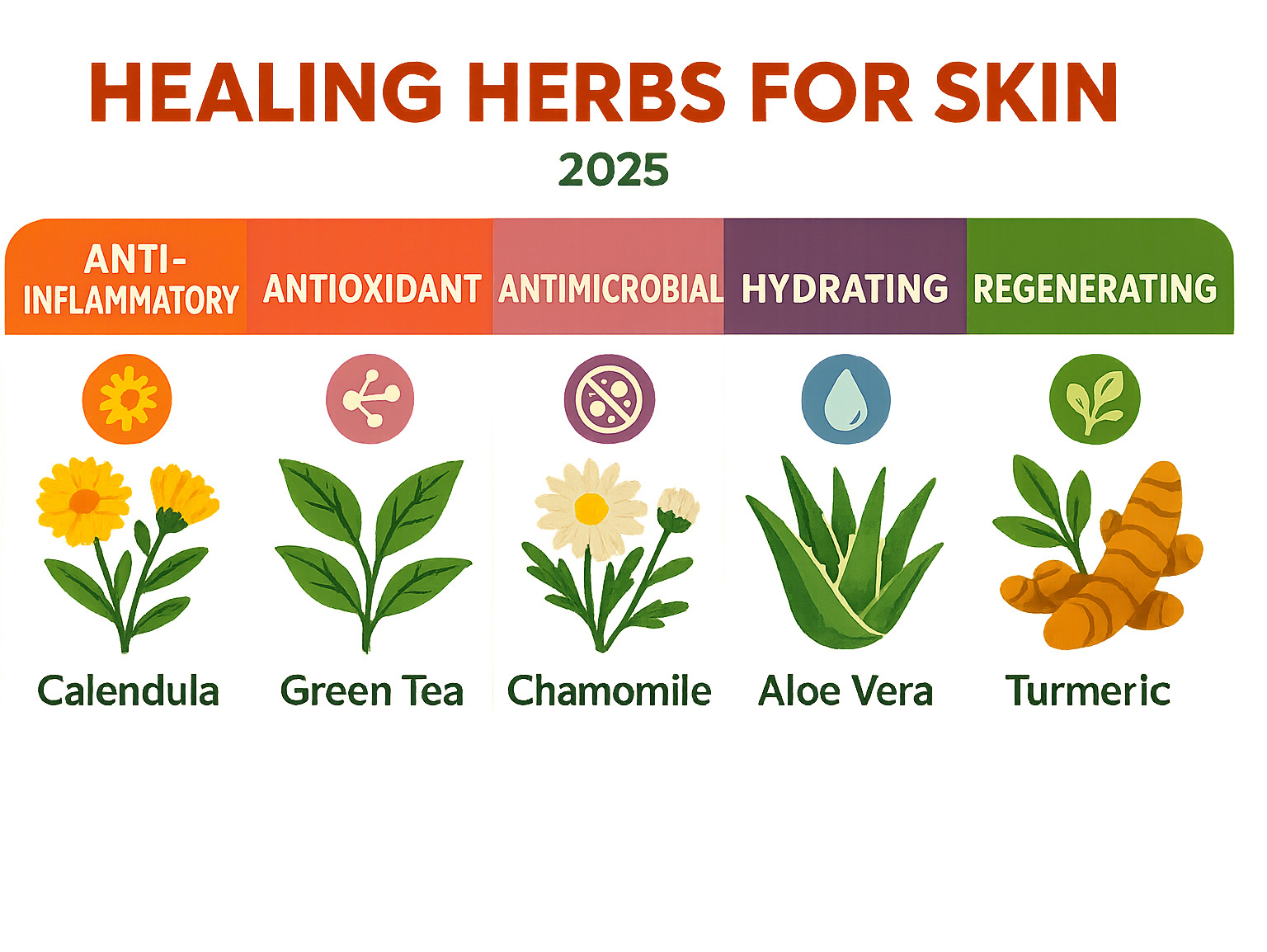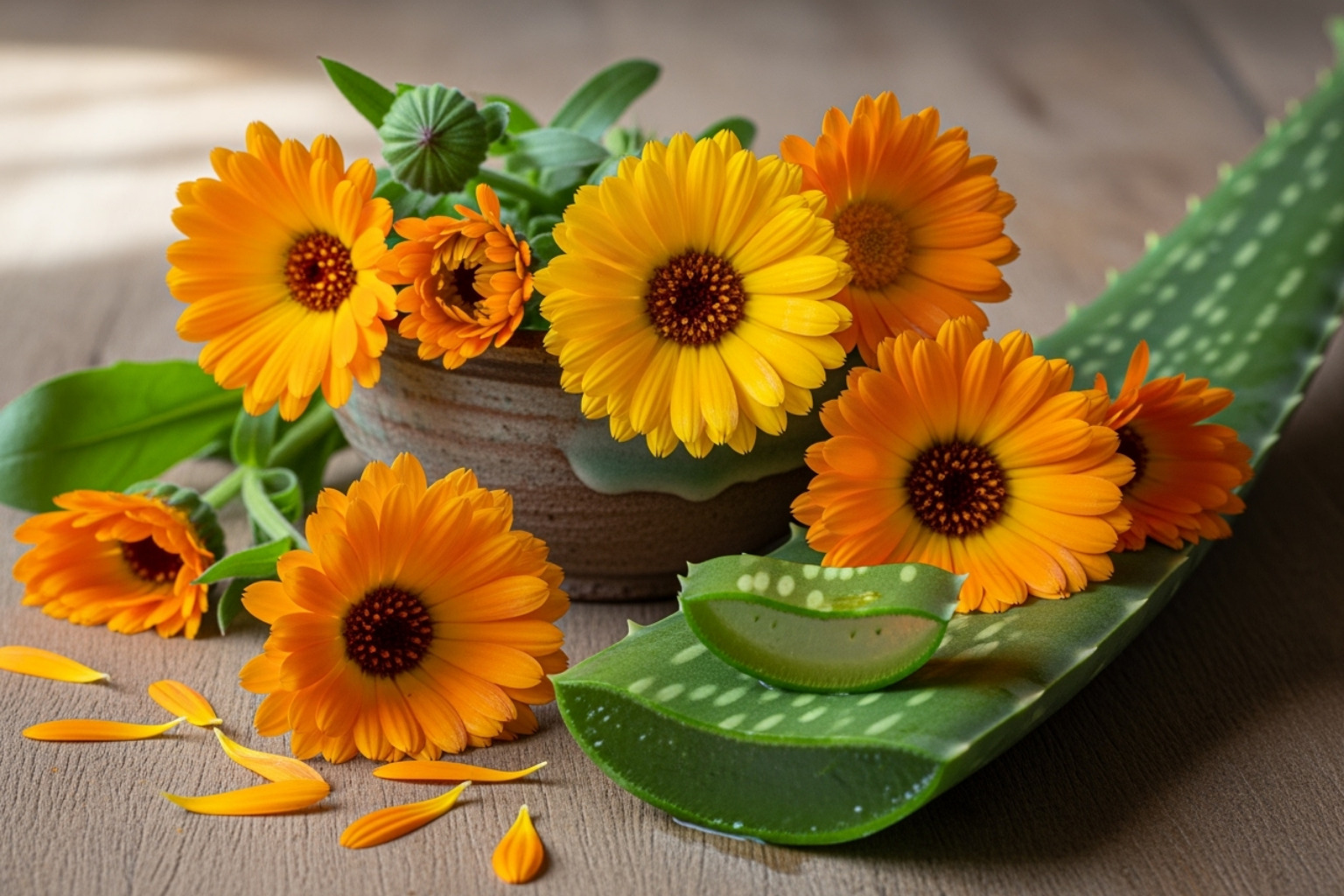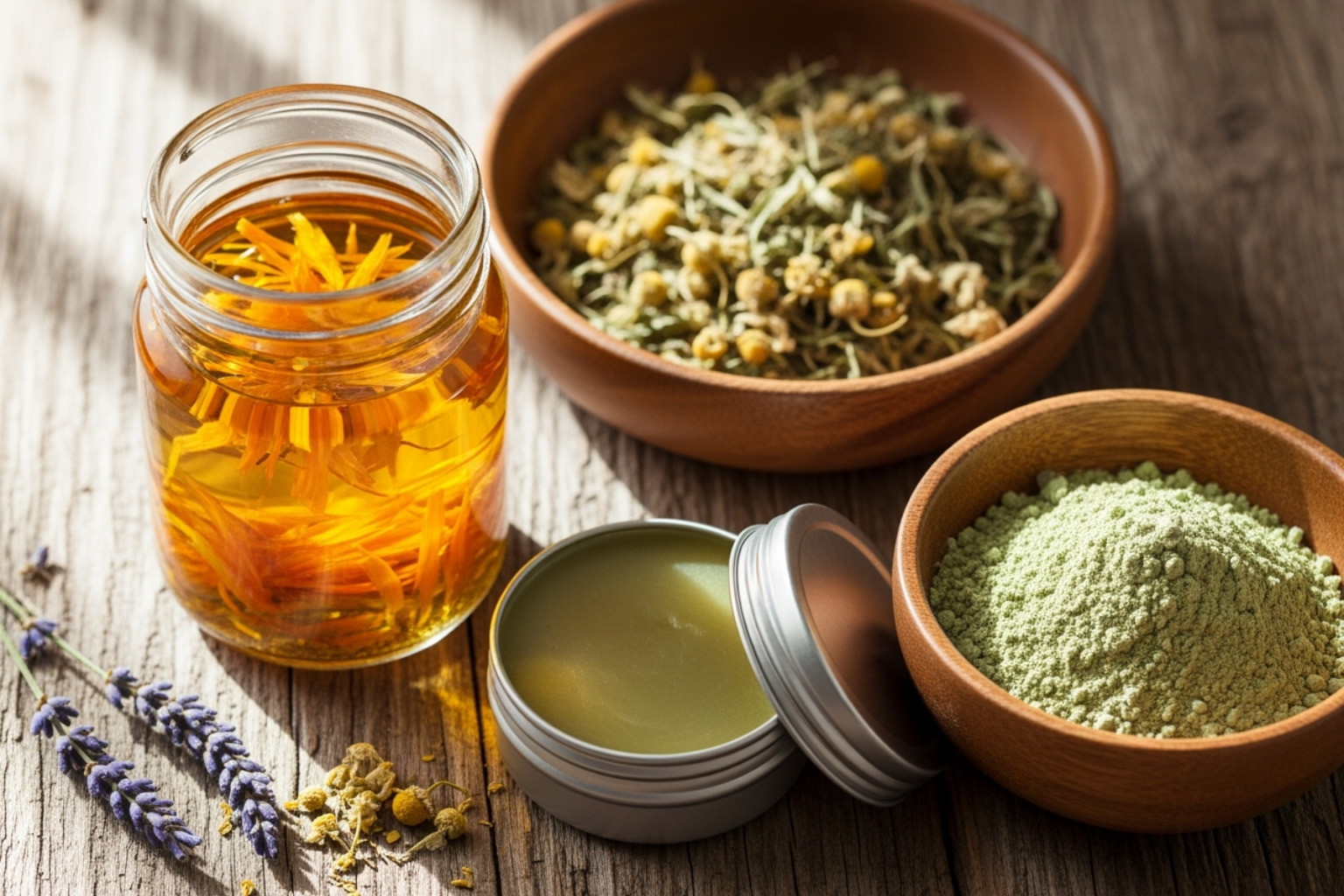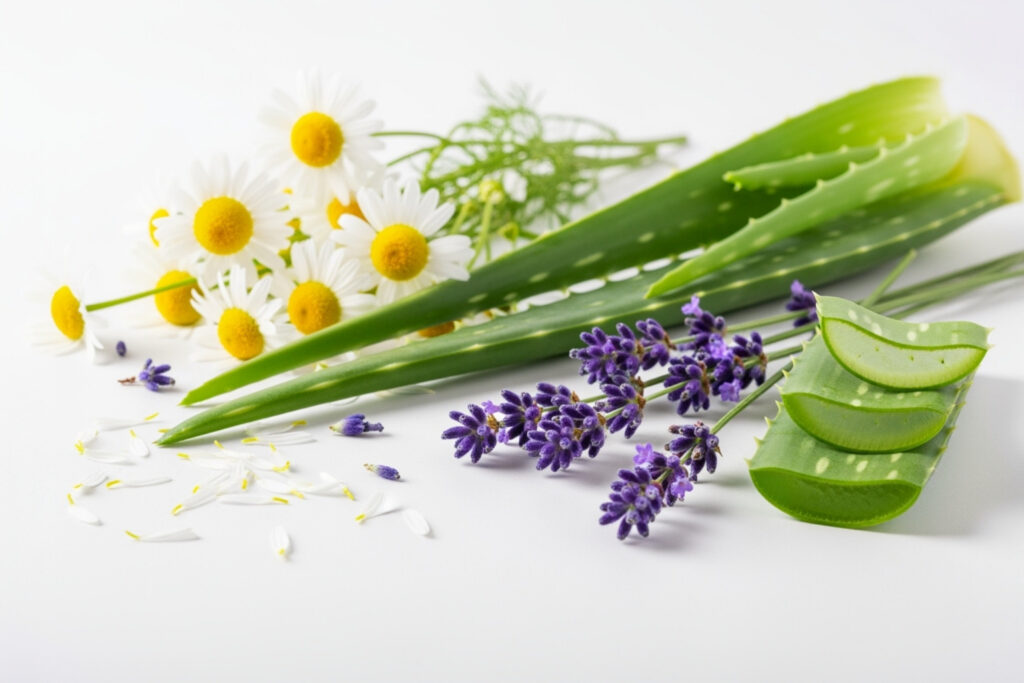Showing Nature’s Skincare Secrets
Healing herbs for skin are nature’s powerful answer to many common skin concerns. For centuries, people have used plants for their soothing and repairing abilities. Packed with beneficial compounds, they can calm irritation, speed healing, and improve your skin’s natural glow.
If you’re looking for natural skincare remedies, here are some top healing herbs and their benefits:
- Aloe Vera: Famous for its ability to soothe burns and calm irritated skin. It aids in faster healing.
- Calendula: This sunny flower helps reduce inflammation and promotes wound closure. It’s great for damaged skin.
- Chamomile: Known for its gentle, calming properties, it reduces redness and soothes sensitive skin.
- Green Tea: Full of antioxidants, it protects skin from damage and helps with anti-aging.
- Turmeric: A powerful anti-inflammatory, it can cleanse and brighten the skin.
As we seek more natural ways to care for ourselves, healing herbs are stepping into the spotlight. They offer a holistic path to healthier skin, working with your body’s own healing powers.

The Science Behind Skin Aging and Herbal Solutions
Our skin is a marvelous organ and our body’s biggest protector. It works tirelessly as a personal shield, guarding you from the world.
At the heart of healthy, youthful-looking skin are two superstar proteins: collagen and elastin. Collagen is like the scaffolding of your skin, giving it firmness and structure. Elastin, on the other hand, is what allows your skin to bounce back, keeping it supple and smooth.
Our skin changes over time due to natural aging, influenced by biology, sun exposure, and pollution. These factors lessen our skin’s youthful bounce. After age 30, our skin can lose about 1% of its collagen each year. Over time, this adds up, leading to less firm skin and the appearance of fine lines and wrinkles.
Another change we see as we get older is that our skin cells don’t renew as quickly. When we’re young, our skin cells turn over about once a month. But as we age, this can slow down to two months or even longer. This means those older, duller cells hang around longer, making our skin look less radiant.
And then there are those pesky ‘free radicals.’ These unstable molecules are a big reason why our skin can age faster. They come from things like UV rays, pollution, and even just our body’s natural processes. Think of them as tiny troublemakers that can damage your healthy skin cells, including that precious collagen and elastin. This damage can lead to inflammation, signs of premature aging, and a weakened skin barrier. If you’re curious to learn more about why our skin changes with age, you can explore this article: Why skin wrinkles with age.
But here’s some wonderful news! This is exactly where the magic of healing herbs for skin shines. Many of these plant-based wonders are bursting with powerful antioxidants. Think of antioxidants as nature’s own superheroes, ready to fight off those damaging free radicals. By neutralizing these troublemakers, herbs help shield your skin’s precious collagen and elastin. This helps keep your skin looking youthful and vibrant.
Beyond fighting free radicals, many healing herbs for skin also encourage your skin to renew itself. For example, ingredients like allantoin, found in gentle herbs like comfrey and chamomile, can help new skin cells grow. This keeps your complexion looking fresh and bright.
Then there’s Green Tea, a true superstar! It’s packed with antioxidants that protect your skin cells and can even help boost collagen production. Rosemary is another great ally, known for improving blood flow. Better circulation means more nutrients reach your skin, helping it renew and glow. Even humble alfalfa, rich in beta-carotene, adds its own antioxidant power to support healthy skin.
By bringing these amazing plant helpers into your skincare routine, you’re supporting your skin’s natural ability to stay refreshed and maintain its beautiful, youthful look.
A Guide to the Top Healing Herbs for Skin
When it comes to natural skincare, we’re truly spoiled for choice! Nature provides an incredible “medicine cabinet” of healing herbs for skin, each offering unique benefits to address specific concerns. Think of them as tiny botanical helpers, ready to soothe, protect, and refresh your complexion. Let’s explore some of our favorites, grouped by what they do best.
For Inflammation, Irritation, and Wound Healing

We’ve all dealt with skin inflammation, irritation, or pesky wounds. They can be uncomfortable and affect how our skin looks and feels. Luckily, several herbs are absolute champions at calming things down and speeding up the healing process.
Calendula (Calendula officinalis), or “pot marigold,” is a superstar for soothing irritated skin. Its anti-inflammatory properties help reduce redness and swelling from eczema, psoriasis, and rashes. Calendula is also a powerful healer that actively promotes wound closure. Studies show impressive results: one group treated with Calendula officinalis extract had a 90.0% wound closure rate by day eight, compared to 51.1% in the control group. It also helps reduce radiation-induced dermatitis and works wonders on chapped skin, minor cuts, and bruises.
Then there’s Chamomile (Matricaria recutita and Chamaemelum nobile), which you might know from calming teas. It’s just as gentle and beneficial for irritated skin! Its mild anti-inflammatory and antimicrobial properties make it perfect for skin that’s sensitive, red, or itchy. A 2021 study even found that compounds in chamomile flowers helped wounds heal faster than a placebo. We often recommend it for soothing sunburn, easing inflammation from acne, and calming baby rashes or tattoo irritation.
Aloe Vera (Aloe barbadensis miller), called the “plant of immortality” by ancient Egyptians, is synonymous with soothing relief. Its clear gel is packed with compounds that reduce swelling and help wounds close faster. Clinical studies have shown its healing powers; one study showed aloe vera hydrogel led to a 29% reduction in healing time and complete wound closure in 15 days. It’s our go-to for burns, insect bites, rashes, and chronic wounds. Its high vitamin E content also provides antioxidant power for skin repair.
Finally, let’s talk about Yarrow (Achillea millefolium). Legend has it that the Greek hero Achilles used this herb to heal wounds during the Trojan War – that’s why it’s named after him! This herb is a fantastic first-aid friend for fresh wounds, scrapes, and cuts because it can help stop bleeding when applied topically. It also has anti-inflammatory and antiseptic properties, which means it helps prevent infection and reduce swelling. Definitely a valuable addition to any skin-healing kit!
These amazing healing herbs for skin offer soothing relief for common skin concerns. They’re perfect for easing the discomfort of eczema, psoriasis, rashes, minor cuts, abrasions, sunburn, bruises, and insect bites. They also work wonders on chapped skin, dermatitis, and even skin ulcers, bringing comfort and speeding up recovery from irritation and inflammation.
For Hydration and Repairing the Skin Barrier
A healthy skin barrier is crucial for keeping moisture in and protecting skin from environmental aggressors. When this barrier is weakened, skin can become dry, sensitive, and prone to damage. Fortunately, certain healing herbs for skin are excellent at hydrating and strengthening this vital layer. For a deeper dive, you can explore scientific research on the skin barrier.
First up, we have Marshmallow Root (Althaea officinalis). While its name might make you think of sweet treats, this herb is a true champion of hydration. Marshmallow root contains mucilage, a slippery, gel-like substance. Applied to skin, it forms a protective, soothing coating incredibly effective at trapping moisture. This keeps skin hydrated, plump, and wonderfully soft. We find it especially helpful for dry, dehydrated, or environmentally stressed skin, as it brings back comfort and elasticity.
Jojoba Oil (Simmondsia chinensis) is a liquid wax very similar to your skin’s natural sebum. This makes it compatible with all skin types, even oily or acne-prone, as it won’t clog pores. It also helps your skin produce more collagen I, essential for firm skin. It forms a breathable, protective layer that locks in moisture without feeling heavy, leaving skin soft and smooth.
And don’t underestimate Plantain (Plantago major)! Often seen as a common weed, plantain is a powerhouse for skin repair and hydration. It’s incredibly soothing when applied, excellent for chapped hands, insect bites, and minor wounds. Like marshmallow, plantain contains mucilage, contributing to its moisturizing and soothing abilities. It also has toning and healing qualities, helping firm the skin and promote tissue repair while preventing moisture from escaping. We love it for its ability to soften rough patches and help damaged skin recover.
These wonderful healing herbs for skin act like natural emollients (softeners) and humectants (moisture magnets). They work together to strengthen your skin’s barrier, prevent moisture loss, and soften rough or damaged skin. The result? A more resilient and hydrated complexion that feels comfortable and protected, ready to face the world!
For Cleansing, Brightening, and Acne-Prone Skin
Achieving clear, bright, and balanced skin, especially if you’re prone to breakouts, is a common goal. It can feel like a never-ending battle sometimes! But thankfully, many healing herbs for skin offer remarkable cleansing, detoxifying, and brightening properties. They make excellent allies in managing acne, excess oil, and uneven skin tone, helping you achieve that radiant glow.
Let’s start with Nettle (Urtica dioica). Yes, it might sting when fresh, but once it’s processed, nettle becomes a gentle giant for skin health! When taken internally, nettle is a fantastic detoxifier, helping to purify your bloodstream and get rid of toxins that can contribute to breakouts. When used on your skin, it’s wonderful for treating inflammatory skin issues, clearing up eczema, and helping to heal skin wounds and ulcers. Its natural cleansing action helps to clarify congested skin, making it look brighter and healthier.
Then there’s Witch Hazel (Hamamelis virginiana), a true classic for skincare. This plant is perfect for tightening and toning your skin while effectively whisking away excess oil and impurities. It helps to minimize the appearance of pores and can reduce the redness and swelling that come with acne. Its mild antiseptic properties also make it useful for preventing future breakouts and calming existing irritation. We often recommend it as a gentle, natural toner for those with oily or acne-prone complexions.
Next up is White Willow Bark (Salix alba). This bark is a natural source of salicin, a compound that’s very similar to salicylic acid, which you’ll often find in acne treatments. White willow bark gently exfoliates your skin, helping to shed dead skin cells and unclog pores, which can prevent pesky blackheads and whiteheads from forming. Its anti-inflammatory properties also help to calm existing breakouts and reduce redness. It’s a milder, more natural alternative to synthetic exfoliants, helping to promote clearer skin without harsh irritation.
Turmeric (Curcuma longa) is a vibrant spice and a powerhouse of anti-inflammatory and antioxidant compounds, especially curcumin. Used for centuries in Ayurvedic medicine for skin problems like acne and eczema, it works by reducing inflammation and fighting acne-causing bacteria. When ingested, it can help detoxify the blood system to support clearer skin. Its brightening properties can also help fade hyperpigmentation and dark spots for a more radiant skin tone. Be aware: its strong yellow pigment can temporarily stain skin in high concentrations.
These incredible healing herbs for skin help manage sebum, offer natural exfoliation, and have antimicrobial actions important for preventing and treating breakouts. By bringing them into your routine, you can cleanse, detoxify, and brighten your skin for a clear, luminous complexion.
How to Incorporate Healing Herbs into Your Skincare Routine

Now that we’ve explored the benefits of healing herbs for skin, let’s discuss how to use them. Herbal remedies can be prepared in many ways, either made at home or found in ready-made products.
One popular way to use herbs is through infused oils. This means soaking herbs in a carrier oil like olive, jojoba, or almond oil. The oil soaks up all the good stuff from the herbs. Then, you can use this potent oil directly on your skin. Think of calendula-infused olive oil for dry skin, or St. John’s Wort oil for soothing nerve pain or conditions like eczema.
Next up are salves and balms. These are solid versions of infused oils, often made with beeswax. They create a protective and healing layer on your skin. A great example is a skin healing salve made with red clover and calendula. It’s wonderful for dry patches, minor cuts, rashes, or bug bites.
You can also use tinctures and extracts. These are concentrated liquids made by steeping herbs in alcohol or glycerin. You can apply them to your skin (often diluted) or even take them by mouth for benefits that show up on your skin. An herbalist once told us how a calendula tincture helped clear chickenpox and relieve itching!
For a relaxing treat, try herbal steams. It’s super simple! Just add herbs like horsetail or chamomile to hot water. Then, lean over the steam with a towel over your head. This opens your pores and helps the herbal goodness sink in. Horsetail, for example, is known for making skin supple and healthy.
Have you heard of poultices? These are crushed fresh or dried herbs, often mixed with a bit of water to make a paste. You apply them directly to your skin. Poultices are great for drawing out impurities, calming inflammation, and speeding up healing. A simple poultice of fresh self-heal leaves can cleanse small wounds. And yes, you can even make a “spit poultice” in a pinch – though we agree, it’s not the tastiest option!
Feeling creative? Make your own DIY face masks! Powdered herbs are perfect for this. Rose hips, full of Vitamin C, make a brightening mask. Turmeric can be used for its anti-inflammatory and brightening effects too.
If DIY isn’t your thing, that’s totally fine! Many high-quality store-bought formulations use the power of healing herbs for skin. When shopping, look for brands that use clean ingredients and are clear about what’s in their products. You’ll often find herbs like aloe, lavender, and tea tree in commercial scar-reducing creams.
No matter how you use these herbs, consistency is key. True healing takes time, so be patient. With regular use, you’ll notice healthier, stronger, and more vibrant skin. For more insights on natural beauty, be sure to check out our clean beauty guides.
Safety First: What to Know Before Using Herbal Remedies
Healing herbs for skin offer incredible natural benefits, but it’s crucial to use them with knowledge and caution. “Natural” doesn’t mean “risk-free,” and understanding key considerations is paramount for a safe and effective skincare journey.
First things first, let’s talk about patch testing. This is always a must before applying any new herbal preparation to a large area. Dab a tiny bit on an inconspicuous spot, like your inner forearm, and wait 24 to 48 hours. This simple step lets you check for any redness, itching, or irritation and can save you a lot of discomfort.
Next, be mindful of allergic reactions. Just like with any plant, some individuals might be allergic to specific herbs. For instance, if you know you’re sensitive to plants in the daisy family (that includes ragweed, chrysanthemums, and, yep, daisies!), you should be extra careful with or even avoid herbs like calendula and chamomile, as they belong to this group. If you ever notice hypersensitivity or an allergic reaction, stop using the product right away.
Another important point is photosensitivity. Certain herbs can make your skin more sensitive to the sun, which could lead to sunburn or rashes. St. John’s Wort is a notable example; if you’re using products that contain this herb, make sure you’re diligent with your sunscreen and limit your time in direct sunlight.
The effectiveness and safety of your herbal remedies really depend on the quality of the herbs themselves. Always look for products that are independently tested and certified. Labels like “Organic Herbs” or “Wildcrafted Herbs” are great signs, as they ensure purity and potency, free from unwanted pesticides or contaminants. If you’re lucky enough to harvest your own, be sure they come from clean, unpolluted areas.
Natural solutions are not a substitute for professional medical advice, especially for severe skin conditions. Always consult a dermatologist or healthcare provider if your symptoms worsen, last more than seven days, or if you are pregnant or breastfeeding. It’s also wise to discuss herbal remedies with your doctor or pharmacist if you’re taking other medications, as some can have serious drug interactions. For example, St. John’s Wort can interact with antidepressants, and turmeric can boost the effects of blood thinners.
Speaking of specific situations, some herbs are contraindicated during pregnancy (like ashwagandha, due to miscarriage risk) or for certain age groups (such as willow bark, which should be avoided in children under 16 with a viral illness due to Reye’s syndrome risk). Always do a quick check for any specific contraindications for each herb you plan to use.
Finally, keep these specific warnings in mind for popular herbs:
- Arnica: Wonderful for bruises, but never apply it to broken skin.
- Comfrey: A powerful healer, but it can heal a wound’s surface too quickly, trapping infection. Save it for surface scrapes, not deep punctures.
- Witch Hazel: This toner is for external use only; ingesting it can cause serious internal damage.
- Chamomile: Use with caution if you’re taking blood thinners or cyclosporine.
- Echinacea: Recommended for short-term use (less than eight weeks) and should be avoided by those with autoimmune diseases.
- Lavender Essential Oil: Never consume orally. Always dilute with a carrier oil before applying to your skin.
- Garlic: Avoid large amounts before surgery or dental procedures due to increased bleeding risk.
By keeping these safety considerations in mind, you can confidently and responsibly incorporate healing herbs for skin into your wellness routine, using nature’s power while protecting your skin’s health.
Frequently Asked Questions about Healing Herbs for Skin
We often get questions from our community about how to best integrate healing herbs for skin into their lives. It’s wonderful to see so much curiosity about nature’s remedies! Here are some of the most common inquiries we receive, along with our insights:
Can I use herbs from my garden for skincare?
Yes, using fresh herbs from your garden can be a rewarding experience, offering a direct connection to nature’s healing power. However, there are a few crucial considerations for safety and effectiveness.
First, accurate identification is key. Before you apply anything to your skin, you must be 100% sure you know exactly what herb you’re using. Misidentifying a plant can lead to using something ineffective or, worse, potentially harmful. Stick to herbs you know well.
Second, think about your garden’s environment. Are your herbs truly clean and free from chemical pesticides, herbicides, or other pollutants? Herbs are like little sponges, absorbing what’s around them, and you certainly don’t want to transfer any toxins to your skin. This also goes for wild herbs – avoid harvesting from roadsides or contaminated areas.
Finally, understand the proper preparation methods for fresh herbs. This could mean washing, drying for infusions, or crushing them into a poultice. Knowing the right way to prepare each herb ensures you get its therapeutic properties. If you’re new to this, start with easily identifiable and safe herbs like chamomile, calendula, or a fresh aloe vera leaf.
How long does it take to see results from herbal skincare?
This is a fantastic question, and the answer, like many things in nature, varies from person to person and from herb to herb.
Some healing herbs for skin, like aloe vera or chamomile, can offer immediate soothing relief for acute irritation, almost like a comforting hug for your skin. But for deeper concerns like chronic inflammation, persistent acne, or the ongoing journey of anti-aging, you’ll find that results take a little more time.
The secret ingredient is consistency. Herbal remedies work best when used regularly over time, much like nourishing your body with a healthy diet. It’s not an overnight fix; instead, herbal skincare works by gently supporting your skin’s natural healing and balancing processes.
You might start to notice subtle improvements within a few weeks, with more significant, cumulative benefits appearing over several months of dedicated use. For example, some herbs take time for their full benefits to become noticeable. The most important thing? Listen to your skin. It’s always having a conversation with you, so pay attention to how it responds and adjust your routine as needed. Patience and consistency are your best friends on this herbal skincare journey!
Are store-bought herbal products more effective than DIY remedies?
This is a common debate, and both store-bought herbal products and DIY remedies have their own unique merits. The “effectiveness” often comes down to your individual needs, preferences, and what you’re hoping to achieve.
Reputable companies creating store-bought products have the advantage of formulation science. Professionals use their expertise to create potent, stable, and safe products. They understand how to extract compounds, how ingredients work together, and how to preserve a product. This means store-bought items can have higher, standardized concentrations for consistent potency. They’re also formulated for stability and offer great convenience.
On the other hand, DIY remedies offer incredible customization. You have complete control over every single ingredient, allowing you to tailor your skincare precisely to your unique skin needs and preferences. This also means you have full control over the purity of your DIY creation – you know exactly what’s going into it, which is a huge advantage if you’re concerned about additives or synthetic ingredients.
When you’re choosing store-bought herbal products, we always advise looking beyond just seeing an herb listed. Take the time to check ingredient lists for concentration of the herbal extract and the overall quality of the ingredients to ensure you’re getting a genuinely beneficial product, not just a marketing gimmick.
The best approach for your journey with healing herbs for skin might be a beautiful combination of both: using high-quality store-bought products for complex formulations that require specific expertise, and enjoying the simplicity and personal touch of DIY remedies for your everyday needs.
Conclusion
We’ve journeyed into nature’s apothecary and explored how healing herbs for skin are nature’s miracles. They offer a gentle yet powerful way to nurture your skin to health and radiance. From calming redness and speeding healing to deeply hydrating and fighting signs of aging, these botanicals work in harmony with your body.
Bringing herbs into your skincare isn’t just a fleeting trend. It’s a beautiful step back to ancient wisdom, now fully supported by modern science. It’s all about taking charge of your skincare journey with solutions that are both natural and effective. This approach is truly holistic, looking at your skin’s health from both the outside in, and the inside out.
Here at Beyond Beauty Lab, we’re passionate about sharing knowledge that empowers you. We want you to feel confident making informed choices for your beauty and overall well-being. We truly believe that genuine beauty starts from a place of inner health and balance. And understanding the incredible gifts nature offers is a huge part of that journey.
So, go ahead! Dive deeper into these amazing herbs. Listen closely to what your skin is telling you. We promise, the profound benefits nature has waiting for you are truly worth finding.
Ready for more tips to empower your self-care routine? We invite you to Explore more wellness tips and insights.







